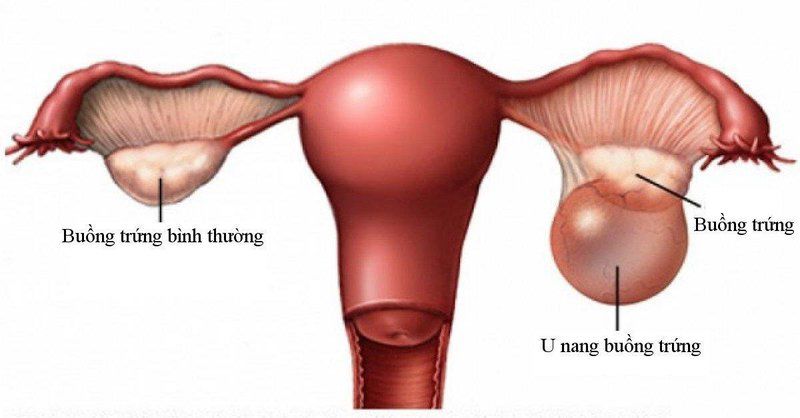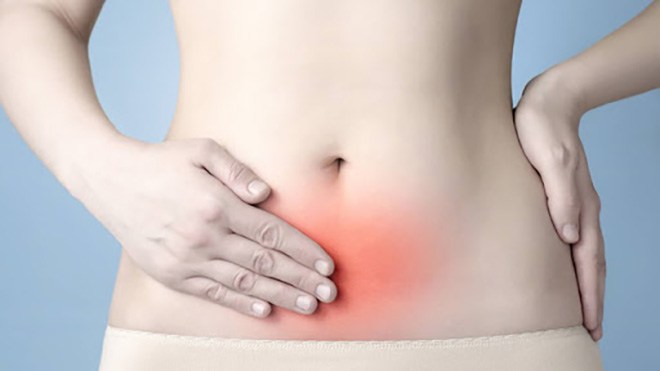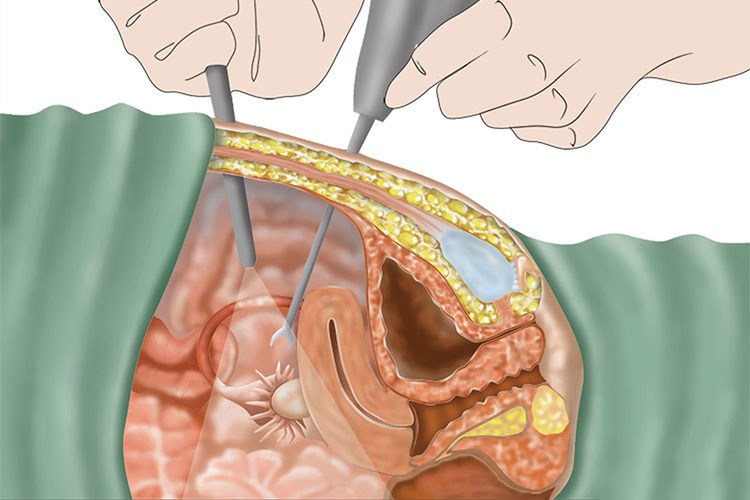Right ovarian cyst: Causes, treatment and prevention (Gynecological disease in women)
Ovarian cysts must be a common disease in women but have a significant effect on fertility in women. This is considered one of the causes of infertility in women.
What are ovarian cysts and ovarian cysts?
Types of right ovarian cysts
Symptoms of right ovarian cysts
Complications of right ovarian cysts
Treatment of right ovarian cysts
How to prevent right ovarian cysts
What are ovarian cysts and ovarian cysts?


Ovaries are an important part of the female reproductive system. They are located on the abdomen on either side of the uterus. Women have two ovaries to produce eggs as well as produce the hormones estrogen and progesterone.
In some cases, a fluid-filled sac called a cyst will develop on one of the ovaries. Many women will develop at least one cyst during their lifetime. In most cases, cysts are painless and cause no symptoms.
Ovarian cysts must be a form of ovarian cysts. This is a more common condition for women than left ovarian cysts

Types of right ovarian cysts
There are many types of ovarian cysts, such as skin cysts and endometriosis cysts. However, functional cysts are the most common type. There are two types of functional cysts, including oocyte cysts and luteal cysts.
1. Ova cyst
During a woman's menstrual cycle, an egg develops in a pocket called an follicle or ovule. This bag is located inside the ovary. In most cases, this capsule or sac breaks and releases an egg. But if the follicle does not break, the fluid inside the follicle can form an ovarian cyst.
2. Cyst of the corpus luteum
The follicles usually dissolve after the release of the egg. But if the bag does not dissolve and the opening becomes open, the liquid will overflow and grow inside the bag, and the buildup of the fluid causes a cyst of the corpus luteum.
3. Other types of ovarian cysts include:
- Cystic dermatitis: growth similar to the cyst on the right and inner ovaries may contain hair, fat and other tissues.
- Cyst: the growth of normal cysts can develop on the outer surface of the right ovary.
- Endometriosis: The tissue usually growing inside the uterus can develop outside the uterus and attach to the right ovary, resulting in the right ovarian cyst.
Some women develop a condition called polycystic ovary syndrome. This condition means that the ovaries contain a large number of small cysts. It can cause the ovaries to expand. If not treated promptly, polycystic ovaries can cause infertility.
Symptoms of right ovarian cysts
Typically, ovarian cysts must not cause any symptoms. However, symptoms may appear as the cyst develops. Symptoms may include:
- Flatulence or bloating
- Bowel movement causes pain.
- Pelvic pain before or during the menstrual cycle.
- Pain during sex.
- Pain in the lower back or thigh.
- Soft breasts.
- Nausea and vomiting.
Severe symptoms of ovarian cysts that require immediate medical attention include:
- Severe pelvic pain.
- Fever.
- Fainting or dizziness
- Breath fast.
These symptoms may be a sign of a cyst rupture or ovarian torsion. Both complications can have serious consequences if not treated promptly.

Complications of right ovarian cysts
Most ovarian cysts must be benign and naturally resolve without treatment. These cysts usually do not cause very few symptoms. But in rare cases, a doctor can detect malignant ovarian cysts (cancer) during routine checkups.
Ovarian torsion is another rare complication of the right ovarian cyst. This is the case when a large cyst causes the ovaries to twist or move out of place. The blood supply to the ovaries is cut off, and if left untreated, it can cause damage or necrosis of ovarian tissue. Although uncommon, ovarian torsion accounts for nearly 3% of emergency gynecological surgeries.
Breaking cysts are also quite rare, can cause intense pain and internal bleeding. This complication increases the risk of infection and can be life threatening if left untreated.
Diagnosis of right ovarian cyst
Your doctor may detect right ovarian cysts during routine gynecological exams. They may notice a large swollen mass in your right ovary and require an ultrasound examination to confirm the presence of a cyst. Ultrasound is an imaging test that uses high frequency sound waves to create images of your internal organs. Ultrasound tests help determine the size, location, shape and composition (solid or liquid) of a cyst.
Imaging tools used to diagnose ovarian cysts must include:
- CT scan: a device that captures images of the body used to create cross-sectional images of internal organs.
- MRI: a test that uses a magnetic field to create images deep inside the internal organs.
- Ultrasound: a device used to take ovarian images.
Because most cysts will disappear after a few weeks or months, your doctor may not recommend an immediate treatment plan. Instead, your doctor may continue the scan for a few weeks or months to check on your condition.
If there is any change in your condition or if the cyst increases in size, your doctor will order additional tests to identify other causes of these symptoms. Include:
- Get a pregnancy test to make sure you're not pregnant
- Check hormone levels to check for hormone-related problems, such as too much estrogen or progesterone.
- CA-125 blood test to screen for right ovarian cancer.
Treatment of right ovarian cysts
Your doctor may recommend treatment to shrink or remove the cyst if it does not go away on its own or if it grows larger.
1. Birth control pills
If you have recurrent ovarian cysts, your doctor may prescribe birth control pills to stop ovulation and prevent the growth of new cysts. Oral contraceptives may also reduce the risk of ovarian cancer. The risk of ovarian cancer will be higher in menopausal women.
2. Laparoscopy
If your cyst is small and results from imaging tests to rule out cancer, your doctor may perform laparoscopic surgery to remove the cyst. The procedure involves your doctor making a small incision near your navel and then inserting a small instrument into the abdomen to remove the cyst.

3. Endoscopic surgery
If you have a large cyst, your doctor may surgically remove the cyst through a large abdominal incision. They will undergo an immediate biopsy and if they determine that the cyst is cancerous, they may have a hysterectomy to remove your ovaries and uterus.
How to prevent right ovarian cysts
Ovarian cysts must be preventable. However, routine gynecological exams can detect early right ovarian cysts. Ovarian cysts must be benign and likely to become cancerous. However, the symptoms of ovarian cancer may closely resemble those of the right ovarian cyst. Therefore, it is important to see a doctor and get an accurate diagnosis. Give your doctor symptoms that can help them diagnose:
- Changes in your menstrual cycle.
- Constant pelvic pain.
- Loss of appetite.
- Unexplained weight loss.
- Full stomach.
Premenopausal women have a higher risk of ovarian cysts than normal. Most cysts will disappear within a few months. However, recurrent ovarian cysts can occur in premenopausal women and women with hormone imbalances.
If left untreated, some cysts can impair fertility. This is common with endometriosis and polycystic ovary syndrome. To improve fertility, the doctor may remove or shrink the cyst. Functional cysts, cysts, and cysts do not affect fertility.
Although some doctors wait and see an approach to ovarian cysts, they may recommend surgery to remove and check for any cysts or growths on the ovaries after they are full. Kinh. This is due to an increased risk of developing cysts becoming cancer or ovarian cancer after menopause. However, ovarian cysts do not increase the risk of ovarian cancer. Some doctors will remove the cyst if it is larger than 5cm in diameter.
- 4 food should not be fed to children under 1 year of age, otherwise it will be very dangerous
- The safest ways to supplement calcium for infants
- Appropriate dosage and supplementation of vitamin D for newborns
- 9 old child care concepts, parents think good but doctor shakes his head
- If parents do not immediately dismiss this misconception, their teeth will soon collapse
VACXIN VIETNAM JOINT STOCK COMPANY
Certificate of Business Registration No. 0107631488 by the Department of Planning and Investment City. Hanoi issued on 11/11/2016
Address: 180 Truong Chinh, Khuong Thuong Ward, Dong Da District, City. Hanoi
Mail: [email protected]
Hotline: 028 7300 6595
Working time: From Monday to Sunday
From 7:30 - 17:00 (no lunch break)
117-119 Ly Chinh Thang, Ward 7, District 3, City. Ho Chi Minh